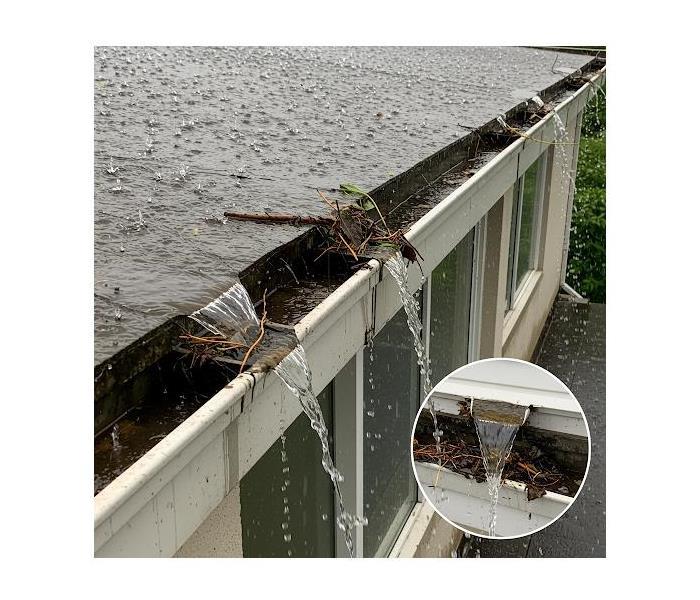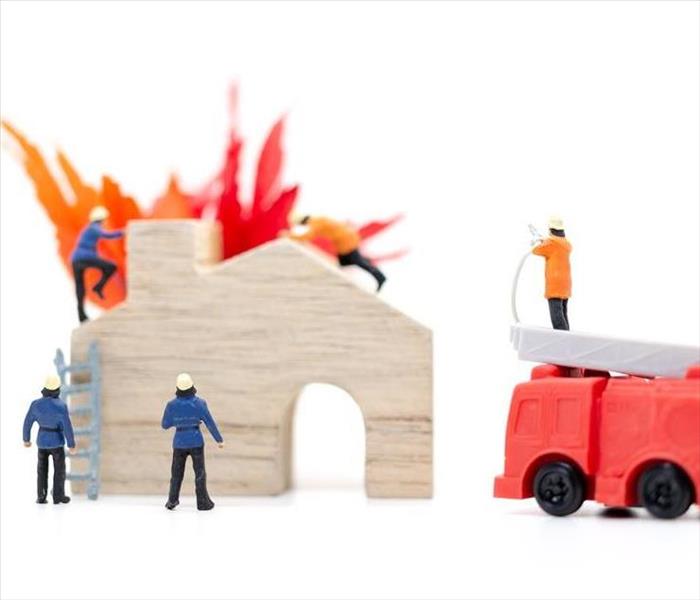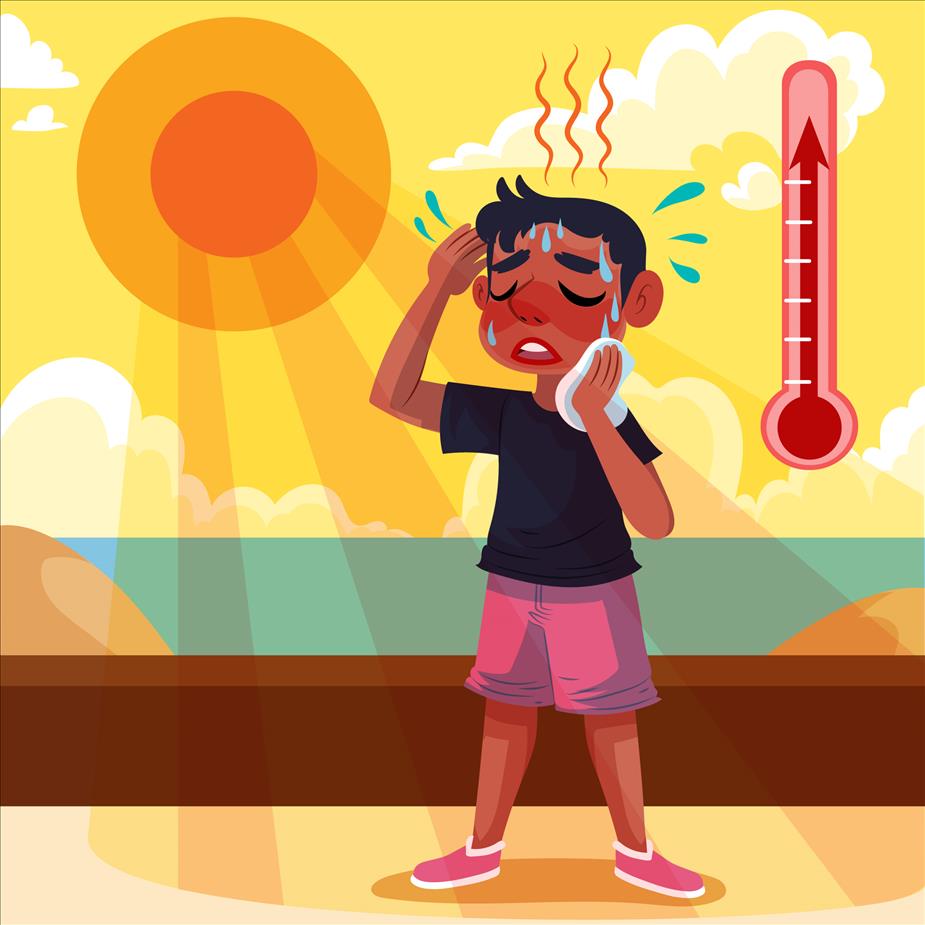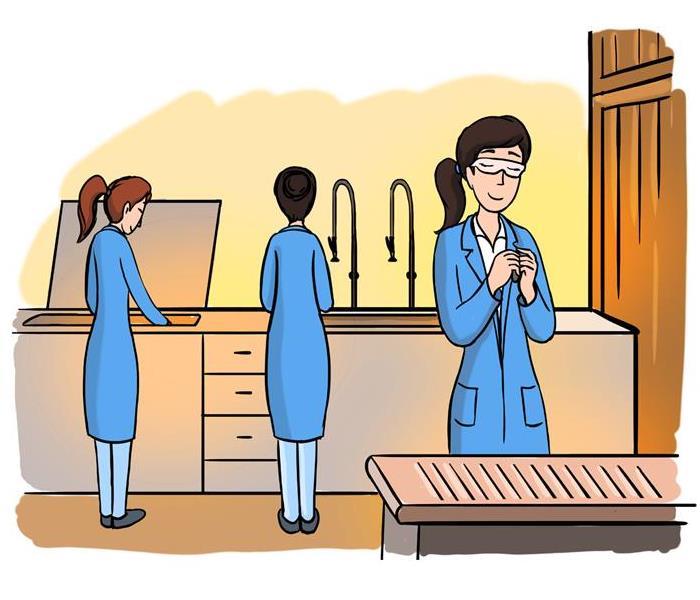Recent General Posts
Preventing Common Property Disasters: Tips for Property Managers During Spring
3/13/2025 (Permalink)
 Protect your property with Spring season maintenance
Protect your property with Spring season maintenance
Spring's arrival signals a welcome change, but for property managers, it also means a new set of challenges. Melting snow, increased rainfall, and fluctuating temperatures can lead to a host of property disasters if preventative measures aren't taken. Here's a comprehensive guide to help you protect your investments and ensure a smooth spring season:
1. Water Damage: The Prime Culprit
- Roof Inspection:
- Thoroughly inspect roofs for damaged shingles, leaks, and debris buildup. Winter storms can cause significant damage that becomes apparent during the spring thaw.
- Check for ice dam damage, which can lead to water seepage into attics and walls.
- Clean gutters and downspouts to ensure proper drainage. Clogged gutters can lead to overflowing water and foundation damage.
- Foundation Checks:
- Examine foundations for cracks or signs of water intrusion. Spring rains can exacerbate existing cracks, leading to structural issues.
- Ensure proper grading around the property to direct water away from the foundation.
- Check basement and crawlspace for dampness or standing water. Install sump pumps if needed.
- Plumbing System:
- Inspect pipes for leaks and damage caused by freezing temperatures.
- Test sump pumps and drainage systems to ensure they are functioning correctly.
- Check for signs of backflow in sewer lines.
2. Landscaping Hazards:
- Tree and Limb Inspection:
- Assess trees for weakened branches or signs of disease. Spring storms can cause damaged limbs to fall, posing a safety hazard.
- Trim overgrown trees and shrubs to prevent them from interfering with power lines or causing damage to property.
- Ground Erosion:
- Monitor for soil erosion around the property, especially on slopes.
- Implement erosion control measures, such as retaining walls or proper landscaping.
- check for proper drainage away from walkways and driveways.
- Pest Control:
- With the warmer weather, pests like termites, ants, and mosquitoes become more active. Schedule pest control inspections and treatments as needed.
- Eliminate standing water to prevent mosquito breeding.
3. HVAC and Electrical Systems:
- HVAC System Tune-Up:
- Schedule a spring tune-up for HVAC systems to ensure they are ready for warmer temperatures.
- Check for any damage caused by winter storms.
- Electrical System Inspection:
- Inspect electrical panels and wiring for signs of damage or corrosion.
- Check outdoor outlets and lighting fixtures for weather damage.
4. Tenant Communication and Preparedness:
- Inform Tenants:
- Communicate with tenants about potential spring hazards and maintenance schedules.
- Provide tenants with instructions on how to report leaks or other property issues.
- Emergency Preparedness:
- Review emergency procedures with tenants, including evacuation plans and contact information.
- Ensure that smoke detectors and carbon monoxide detectors are functioning correctly.
Key Takeaways for Property Managers:
- Proactive Inspections: Conduct thorough inspections of all property systems to identify potential issues early.
- Regular Maintenance: Implement a regular maintenance schedule to prevent costly repairs.
- Documentation: Keep detailed records of all inspections, maintenance, and repairs.
- Professional Help: Don't hesitate to seek professional assistance from contractors and specialists when needed.
By taking these preventative measures, property managers can minimize the risk of spring property disasters and ensure a safe and enjoyable season for tenants.
Winter Maintenance Checklist for Your Property
2/1/2025 (Permalink)
 Home is where the warmth is! Stay cozy and safe this winter by prepping your property with our essential maintenance tips.
Home is where the warmth is! Stay cozy and safe this winter by prepping your property with our essential maintenance tips.
Winter is a time for cozy evenings, warm drinks, and the holiday spirit—but it’s also a season that can take a toll on your property if it’s not properly prepared. At SERVPRO®, we understand how important it is to keep your home or business safe, comfortable, and functioning smoothly throughout the colder months. That’s why we’ve created this Winter Maintenance Checklist to help you stay ahead of potential issues. With a little preparation, you can avoid costly repairs and enjoy a worry-free season.
1. Inspect Your Roof
Your roof is your first line of defense against winter weather.
- Check for Damage: Look for missing or damaged shingles, as well as signs of wear that could lead to leaks.
- Clear Gutters and Downspouts: Ensure they are free of debris to prevent ice dams, which can cause water to back up and leak into your property.
- Look Inside for Warning Signs: Check your attic for water stains, mold, or insulation issues that might indicate a roof problem.
Why It Matters: A damaged roof can lead to water damage, mold growth, and structural issues—problems that are not only expensive but stressful.
2. Maintain Your HVAC System
Your heating system works overtime during the winter, and it needs regular maintenance to keep up.
- Replace Filters: Dirty filters can restrict airflow and make your system work harder, increasing energy costs.
- Schedule a Professional Tune-Up: A trained technician can inspect for issues, clean the system, and ensure it’s running efficiently.
- Test Carbon Monoxide Detectors: If you use a furnace or other fuel-burning appliances, ensure detectors are working to protect your family.
Why It Matters: A well-maintained HVAC system not only keeps you warm but also reduces the risk of breakdowns and improves indoor air quality.
3. Protect Your Plumbing
Winter weather can wreak havoc on your pipes if you’re not careful.
- Insulate Pipes: Wrap exposed pipes in unheated areas to prevent freezing.
- Seal Drafts: Check for air leaks around windows, doors, and entry points for plumbing to keep cold air out.
- Keep Water Moving: During extreme cold, let faucets drip slightly to avoid frozen pipes.
Why It Matters: A burst pipe can cause significant water damage, leading to costly repairs and the inconvenience of water disruption.
4. Check Your Insulation
Proper insulation is essential for maintaining energy efficiency and protecting your property.
- Inspect Attic and Walls: Make sure your insulation is adequate and hasn’t been compromised by pests or moisture.
- Seal Gaps and Cracks: Use weatherstripping or caulk to seal air leaks, especially around windows and doors.
Why It Matters: Good insulation keeps your property warm, reduces energy bills, and helps prevent moisture buildup that can lead to mold.
5. Ensure Fire Safety
Winter means more time indoors, often with fireplaces, heaters, and holiday lights.
- Clean Chimneys and Fireplaces: Remove creosote buildup to prevent chimney fires.
- Inspect Space Heaters: Use heaters with automatic shut-off features and place them at least three feet away from flammable objects.
- Check Smoke Alarms: Replace batteries and test alarms to ensure they are functioning properly.
Why It Matters: Fire safety is critical in winter when heating equipment is in high use. A few simple precautions can save lives.
6. Prepare for Winter Storms
In Los Angeles, we may not see heavy snow, but winter storms and heavy rains are still a concern.
- Trim Trees and Branches: Prevent limbs from falling during storms and damaging your property.
- Stock Emergency Supplies: Keep flashlights, batteries, and a first-aid kit on hand in case of power outages.
- Inspect Your Foundation: Check for cracks or leaks that could allow water intrusion during heavy rain.
Why It Matters: Taking steps to prepare for unpredictable weather protects your home from avoidable damage and ensures you’re ready for the unexpected.
SERVPRO® Is Here to Help
At SERVPRO® of Wilshire Center, we care about your safety, comfort, and peace of mind. Taking time to complete this winter maintenance checklist can save you from headaches later in the season.
But if the unexpected happens—whether it’s water damage from a burst pipe or fire damage from a heating mishap—our team is ready to help. With 24/7 emergency service, highly trained technicians, and state-of-the-art equipment, we’ll make it “Like it never even happened®.”
Call us today to schedule a free inspection and learn more about our services. Let us help you protect your property this winter so you can focus on what matters most—enjoying the season.
Staying Vigilant: Navigating Natural Disasters in Los Angeles During the Fall
9/17/2023 (Permalink)
 Staying alert and prepared for natural disasters is essential for the safety and well-being of residents.
Staying alert and prepared for natural disasters is essential for the safety and well-being of residents.
The vibrant city of Los Angeles, nestled on the Pacific coast of Southern California, is known for its sunny skies, picturesque beaches, and a thriving entertainment industry. However, life in the City of Angels also comes with the potential threat of natural disasters, particularly during the fall season. As September ushers in autumn, residents must remain vigilant and prepared for the various challenges posed by wildfires, earthquakes, and other environmental hazards.
1. The Wildfire Season:
September often marks the peak of wildfire season in Southern California. The combination of high temperatures, dry Santa Ana winds, and an accumulation of dry vegetation creates the perfect storm for devastating wildfires. These fires can spread rapidly, threatening homes, communities, and even lives.
What to Do:
- Create a Defensible Space: Maintain a defensible space around your property by clearing away dead vegetation and creating a buffer zone to reduce the risk of your home catching fire.
- Stay Informed: Pay close attention to local authorities and follow evacuation orders if issued. Sign up for emergency alerts and monitor news updates during fire incidents.
- Prepare a Go-Bag: Have an emergency kit ready with essential supplies like water, non-perishable food, first-aid items, and important documents. Include face masks and hand sanitizer to protect against smoke and COVID-19.
2. Earthquake Preparedness:
Los Angeles sits along the Pacific Ring of Fire, making it susceptible to seismic activity year-round. Earthquakes can strike with little warning, and their magnitude can range from minor tremors to major events.
What to Do:
- Secure Your Space: Secure heavy furniture and appliances to prevent them from toppling during an earthquake. Use earthquake-resistant brackets to secure shelves and cabinets.
- Practice Drop, Cover, and Hold On: Familiarize yourself with the "Drop, Cover, and Hold On" technique, which can help protect you during an earthquake. Take part in earthquake drills with your family.
- Prepare an Earthquake Kit: Assemble an earthquake preparedness kit with essentials like water, non-perishable food, a flashlight, batteries, and a first-aid kit.
3. Extreme Heat and Drought:
Fall in Los Angeles often brings high temperatures, which can lead to heatwaves and exacerbate drought conditions. Prolonged heat can strain energy resources and pose health risks.
What to Do:
- Stay Hydrated: Drink plenty of water to stay hydrated and avoid heat-related illnesses. Check on vulnerable neighbors, including the elderly and young children.
- Reduce Energy Consumption: During peak heat, reduce energy consumption to prevent blackouts. Use fans, close blinds to block out the sun, and avoid unnecessary appliance use during peak hours.
- Conserve Water: Given California's history of droughts, continue water conservation efforts. Fix leaks, use drought-resistant plants, and limit outdoor watering.
4. Landslide Awareness:
While less common than wildfires or earthquakes, heavy rains during fall thunderstorms can trigger landslides, particularly in hilly or mountainous areas surrounding Los Angeles.
What to Do:
- Know Your Risk: If you live in a hilly or mountainous area, understand the risk of landslides. Pay attention to weather forecasts and advisories.
- Monitor Your Property: Keep an eye on your property for signs of soil erosion or instability, such as cracks in the ground or shifting foundations.
- Stay Informed: In case of heavy rainfall, stay informed about potential landslide risks and evacuation orders from local authorities.
In Los Angeles, fall is a season of beauty and potential peril. Staying alert and prepared for natural disasters is essential for the safety and well-being of residents. By taking proactive measures, staying informed, and having a well-thought-out emergency plan, Angelenos can navigate the challenges posed by wildfires, earthquakes, extreme heat, and other environmental hazards with resilience and readiness.
<a href="https://www.vecteezy.com/free-photos">Free Stock photos by Vecteezy</a>
Protecting Your Property from Extreme Heat
8/29/2023 (Permalink)
 During the hottest months of the year, it's not just you who feels the heat – your property does too.
Image by Freepik
During the hottest months of the year, it's not just you who feels the heat – your property does too.
Image by Freepik
As the scorching sun beats down during the hottest months of the year, it's not just you who feels the heat – your property does too. Extreme heat can unleash a range of damaging effects on your home, from mold growth and water damage to the risk of fire and smoke infiltration. But fear not, because in the unfortunate event that your property succumbs to these challenges, there's a trusted ally ready to step in. In this article, we'll delve into how extreme heat can wreak havoc on your property and discuss how SERVPRO, the restoration experts, can play a crucial role in bringing your space back to life.
Preventing Damage:
Mold Damage:
As temperatures soar, so does the humidity in the air. This moisture can become a breeding ground for mold if not managed properly. To prevent mold damage:
- Ensure optimal ventilation to curb moisture buildup.
- Harness the power of dehumidifiers to maintain indoor humidity levels.
- Swiftly address leaks to stave off water seepage.
- Bolster insulation to prevent condensation in vulnerable spots.
Water Damage:
Extreme heat can exacerbate existing issues, such as pipe cracks and leaks, leading to water damage. Prevent this by:
- Regularly inspecting and promptly fixing leaks.
- Properly insulating pipes to counteract temperature fluctuations.
- Installing gutter systems and downspouts to direct rainwater away from your property.
Fire Damage:
When extreme heat combines with dry conditions, the risk of wildfires heightens. Protect your property by:
- Creating a defensible space by removing dry vegetation.
- Opting for fire-resistant building materials.
- Keeping roofs and gutters debris-free.
- Adhering to local fire prevention guidelines.
Smoke Damage:
Smoke from nearby fires can infiltrate your property, causing lingering smoke damage. Safeguard against this by:
- Sealing gaps to minimize smoke penetration.
- Closing windows and doors during nearby wildfires.
- Considering high-efficiency air purifiers to filter out smoke particles.
SERVPRO's Assistance:
When preventive measures fall short and damage occurs, SERVPRO, a renowned restoration company, steps in to save the day:
Mold Damage:
- Conducting meticulous mold inspections and assessments.
- Implementing effective containment procedures.
- Safely removing and remediating mold.
- Employing advanced drying techniques to prevent future mold growth.
- Providing expert advice to prevent future mold issues.
Water Damage:
- Rapidly responding to assess and strategize restoration.
- Extracting standing water and meticulously drying affected areas.
- Utilizing cutting-edge moisture detection tools.
- Restoring damaged materials and belongings.
- Applying antimicrobial treatments to halt mold and bacterial growth.
Fire and Smoke Damage:
- Assessing fire, smoke, and soot damage comprehensively.
- Securing your property to thwart additional damage.
- Restoring surfaces marred by residues with precision.
- Eradicating stubborn smoke odors from your space.
- Reinstating or replacing damaged materials as required.
In the heat of the moment, when your property faces the wrath of extreme temperatures, remember that both prevention and restoration are your allies. By heeding practical steps to prevent mold, water, fire, and smoke damage, you're taking a proactive stance against the forces of nature. And if the unexpected does happen, SERVPRO stands ready to offer expert guidance and professional restoration services, ensuring that your property transforms from a place of distress to a haven of comfort once more. In this dynamic dance between nature's challenges and human ingenuity, your property emerges stronger and more resilient than ever.
Cleaning Tips for Repairing Electronics and Recovering Data
6/8/2018 (Permalink)
 Cleaning Tips for Repairing Electronics and Recovering Data
Cleaning Tips for Repairing Electronics and Recovering Data
Electronics are often a top area of concern for homeowners or business owners whose premises have been damaged by fire or flood. From laptop and desktop computers to tablets and smartphones, all the way to high-end entertainment equipment like televisions and stereos, electronic devices are often extremely expensive to replace. To make matters worse, many electronic devices—particularly computers and smartphones—are loaded with data that may or may not be backed up anywhere else.
If you are hoping to recover data from electronics that have been damaged by water or fire, or if you are hoping to salvage and use your devices in the future, then your first step may be a thorough cleaning. Read on to learn more about cleaning tips for water and fire-damaged electronics.
Consider the Degree of Damage
After a fire or flood, electronic devices will generally fall into a few specific categories relating to how salvageable they are. With a fire, it’s fairly easy to tell whether or not your electronics have a chance just by looking at them. A laptop or TV that’s been touched by flames and has visible burn marks has likely been cooked and will be tough to save. Electronics that are merely blackened with soot, however, might have a chance.
With water damage, it’s a lot more difficult to tell whether it’s worth trying to repair your electronics or recover your data. Water damage usually isn’t as fast-acting as fire, nor does it leave such visibly evident scars. Still, water can degrade a hard drive or motherboard more rapidly than you might think, so the number one rule is always to act fast if you want to try to save your stuff.
Electronics that have been submerged in water is increasingly difficult to repair, depending on how long the device in question spent underwater. Electronics that were on at the time of the flood are especially problematic, as they would likely have shorted out upon contact with water.
Devices that you were able to fish out of the water quickly, on the other hand, or that just got splashed or dripped on but never completely submerged, might be able to be salvaged with drying and cleaning. It’s also a good idea to take a closer look at any devices that were located in a flooded room. Many home and business owners assume that devices that didn’t come in contact with any water are fine. However, computers situated in rooms where flooding occurred can often be negatively affected by humidity. It’s a good idea to have these devices looked at and cleaned to make sure they continue to perform optimally.
After a Flood, Keep Your Electronics Wet
Especially if your devices have been submerged in floodwater, you’d do better to keep them wet than try drying them off. Floodwater isn’t just water: it’s full of dirt, sand, sediment, and other minerals. If you try to dry off your electronics now, you might end up making the hard drives and other internal components more difficult to clean. You can towel off the outside of your laptop or phone: just don’t try to dry them with a hairdryer or heater. Otherwise, those foreign particles from the floodwater are going to dry as well, and more or less become one with your device’s interior components.
Call for Help ASAP
Unless you are an electronics expert in your own right, you shouldn’t try to clean your flood or fire-damaged electronics yourself. Instead, call a professional for help. An experienced technician or team will know how to meticulously and safely clean your computer hard drives and other devices. This close and careful cleaning work will give you a better chance of recovering your data or even being able to use your damaged devices again in the future.
Have Questions about Electronic Restoration?
Call Us Today – (213) 263-2292
Critical Elements for Electronic Restoration
6/8/2018 (Permalink)
 Critical Elements for Electronic Restoration
Critical Elements for Electronic Restoration
Electronic restoration is becoming increasingly viable as a method of getting information back from servers and devices that have suffered physical damage. The most common incidents that cause people to consider electronic restoration are fires and floods, which often leave sensitive electronic equipment in terrible shape. However, despite the apparent severity of the damage, it’s often entirely possible to pull data from a machine that has sustained damage in one of these incidents. In some cases, it may even be possible to get the entire machine to work again. However, electronic restoration isn’t a magic wand or a cure-all. There are situations in which it won’t work, so it’s crucial to understand electronic restoration before you assume that you’ll be able to rely on it in the event of an emergency. Here are a couple of things to consider:
What can electronic restoration do?
Electronic restoration is excellent at treating certain kinds of damage and somewhat less effective at treating others. The good news is that in many cases, electronic restoration works wonders on computers and equipment for medical, manufacturing, or telecommunications purposes. Even in circumstances where a piece of equipment has been totally immersed in flood waters or exposed to smoke, corrosive vapors, and extremely high temperatures, electronic restoration can be shockingly effective. The trick is often to remove deposits of foreign materials, and other effects of corrosion. If successful, it’s possible to save the time and money it would take to replace the equipment entirely.
The standard criteria for electronic restoration is as follows: it must be possible to remove the contaminants from all surfaces of the device in question, and this removal must be reproducible rather than dependent on luck. Furthermore, the cleaning must refrain from causing any damage to the device apart from the cosmetic variety, and the process must be either more cost-effective than replacing the device outright or considerably more convenient than waiting for the time it will take to procure the replacement. If you can check those boxes off your list, electronic restoration is a good idea. Here’s a brief description of how it works:
Procedures
The first thing that should be taken care of before successful electronic restoration is the immediate removal of the damaged device from all power sources and the cessation of its use. Following that, the person conducting the restoration process will perform a chemical analysis of the types of any contaminants affecting the machine and their various concentrations. Various protocols, procedures, and chemicals may then be used, depending on the offending substance.
In the case of fire damage, for instance, hydrochloric acid is a common problem—and it can be worse when coupled with the water discharged by a sprinkler system or a hose. To minimize the effects of corrosion, it’s possible to apply a protective lubricant to the damaged components. To limit the chance of further corrosion, it’s best to remove water the room and lower the relative humidity to below 40%. These conditions will prevent a faster chemical reaction between the hydrochloride and the metal from which the affected device is made, buying the technicians much needed time.
Next, the equipment is disassembled, and each component cleaned. Highly trained electronics professionals are used for this step since this part is the most detail oriented and requires considerable knowledge of how to clean each part. Optical and chemical quality testing follows, after which the device is reassembled, adjusted, and returned to service.
Success and Reliability
When restored in this manner, it’s quite common for the damaged electronics to function properly once again, and the data housed inside is frequently intact. 60-70% of electronics treated this way function again without incident, and do not require further repairs. Even over long periods of time, their performance tends to remain at least equal to the way it was before being damaged—and can even improve in some cases. Of course, every damaged unit should be inspected thoroughly to see if it meets restoration criteria, but if it does, then this is an excellent method to restore data and services.
Have Questions about Electronic Restoration?
Call Us Today – (213) 263-2292
The Two Principal Goals of Electronic Restoration
6/8/2018 (Permalink)
 The Two Principal Goals of Electronic Restoration
The Two Principal Goals of Electronic Restoration
When a homeowner or business suffers a disastrous property loss such as a fire, flood, or storm damage, the financial and emotional toll can be devastating. The family may be out of their home for an extended period and may have lost everything including keepsakes and family heirlooms that they cannot replace. A catastrophic business loss may put many people out of work, work on critical projects may be destroyed, and clients may just take their business elsewhere due to time pressures.
Salvaging some of the electronic equipment may ease some of the loss, both financially and emotionally. There are two significant goals to electronic restoration. Data recovery (also known as content restoration), and equipment restoration. These two critical goals are often intertwined, but the accomplishment of each task is not necessarily interdependent.
The goal of most homeowners who have suffered a loss is often the recovery of the digital memories, key documents, photos and videos. Most of us do not give much thought to these items until a loss occurs. Imagine that you suffered a devastating house fire. Your family all got out safely, but your home is now a smoking soggy pile of tinder. Your children’s baby pictures, graduation photos, etc. were in frames all around the home. You felt safe because they were all scanned or downloaded onto your home computer or laptop as a backup. Since the originals were physically destroyed in the fire, your only hope to retrieve them is from your computer. Unfortunately, that is now covered in smoky residue and is soaking wet.
The same may be true of your videos. Your child’s first steps, treasured ballet recitals and Christmas morning videos with astonished toddlers who are now all grown up now exist only on your trusty laptop. You were able to find your laptop after the blaze, but the case and screen are both cracked. You then remember that your grandparents’ original naturalization papers and scanned copies of your father’s distinguished military documents were also on the hard drive.
You had intended to share these items with other family members but just didn’t seem to find the time. Now, they are lost forever.
There is one resource that might be your best chance to recover these items from those damaged hard drives. After a significant loss from a flood, fire or storm, many insurance carriers bring in a service to help clean up the mess, dry or replace carpets, prevent the growth of mold and help you rebuild or restore your home or business. These companies are experienced and excellent at handling these situations. The best companies also have Electronic Restoration specialists to assist them in saving your equipment and mining the critical data from your devices. While repairing the equipment may be technically possible, it does not always make economic sense for outdated equipment. You should also note that it is often possible to retrieve data from the hard drive of a computer without ever making the device operational.
For electronic restoration to be successful, certain steps must be followed:
- You must act quickly. The longer the equipment sits, the more difficult and less chance exists for success. Equipment that is subject to smoke or water will begin to dry out, and the circuit boards may start to rust or short out from the material that accumulated on those boards. As hard drives continue to be subject to exposure to water, dust from fire extinguishers and the elements, there is a greater chance the data contained therein will be inaccessible.
- Determine what type of contamination occurred, whether water, chemical, smoke, fire extinguisher, etc.
- Decide how to restore the item, determine what methods and procedures are most likely to be successful.
- To the extent necessary and feasible, disassemble and clean the components.
- Examine and test the components.
- Reassemble the unit.
- Retest the entire component to make sure it is in good working order and then put back into service.
On many occasions, it’s possible to save business or computer equipment by cleaning or replacing a few key components on the circuit boards. Complete recovery of electronic equipment is not always possible, but even a partial success can save lots of time and money for businesses with specialized equipment that is not only expensive but would take a significant amount of time to manufacture as it was custom made for the company.
If you suffer one of these horrific losses, make sure that you discuss the use of an electronic restoration company with your insurance carrier immediately. If you are a restoration contractor working for an insurance company, contact our Content Restoration Service Division to determine if some of the electronic equipment on your next job can be restored.
Have Questions about Electronic Restoration?
Call Us Today – (213) 263-2292






 24/7 Emergency Service
24/7 Emergency Service






